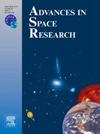Investigation of equatorial plasma bubble irregularities under quiet and disturbed geomagnetic conditions over the East African longitudinal sector in 2015
IF 2.8
3区 地球科学
Q2 ASTRONOMY & ASTROPHYSICS
引用次数: 0
Abstract
In this paper, we investigated the behavior of equatorial plasma bubble irregularities under quiet and disturbed geomagnetic conditions in the year 2015. Total Electron Content (TEC) data was obtained from four Global Navigation Satellite System (GNSS) receivers situated at Addis Ababa (ADIS), Bahir Dar (BDMT), ASAB (ASAB), and Debark (DEBK). We used Rate of TEC change index (ROTI) to describe ionospheric irregularities associated with plasma bubbles. The monthly occurrence rates (MOR) is obtained to be higher in equinoctial and lower in solstitial months at all stations. Moreover, the seasonal occurrence rates of plasma bubbles (SOR) show equinoctial and solstitial asymmetries. The seasonal occurrence rate in March equinox is higher than that of the September equinox during both quiet and disturbed geomagnetic conditions. Similarly, higher occurrence rate is observed in June than December solstice in quiet geomagnetic conditions. We have also investigated that the occurrence rate of plasma bubble is higher in geomagnetic quiet conditions than disturbed conditions at all stations. Moreover, there is also excellent correlation with high degree of significance between the monthly occurrence rates of plasma bubbles and the monthly mean F10.7 index and sunspot number at all stations. The occurrence times of plasma bubbles are almost similar in the four stations and most of the irregularities (around 95 of the total irregularities) are observed in times between postsunset and midnight hours. The daily, monthly, and seasonal variations of ROTI also demonstrate similarity with the variation of the occurrence rates of plasma bubbles.
2015年东非纵向扇区静扰动地磁条件下赤道等离子体气泡不规则性研究
本文研究了2015年赤道等离子体气泡在安静地磁和扰动地磁条件下的不规则行为。总电子含量(TEC)数据是从位于亚的斯亚贝巴(ADIS)、巴希尔达尔(BDMT)、ASAB (ASAB)和Debark (DEBK)的四个全球导航卫星系统(GNSS)接收器获得的。我们使用TEC变化率指数(ROTI)来描述与等离子体气泡相关的电离层不规则性。各站的月发生率(MOR)在春分月较高,在冬至月较低。此外,等离子体气泡(SOR)的季节发生率表现出春分和冬至的不对称性。无论在平静地磁条件下还是在扰动地磁条件下,3月春分的季节性发生率都高于9月春分。同样,在安静的地磁条件下,6月的发生率高于12月至日。我们还研究了各站在地磁安静条件下等离子体气泡的发生率高于扰动条件。各站月平均F10.7指数和太阳黑子数与等离子体气泡的月发生率也有极好的高度显著性相关。在这四个观测站中,等离子体气泡的出现时间几乎是相似的,大部分的不规则现象(约占不规则现象总量的95%)发生在日落后到午夜之间。ROTI的日、月、季节变化也与等离子体气泡发生率的变化具有相似性。
本文章由计算机程序翻译,如有差异,请以英文原文为准。
求助全文
约1分钟内获得全文
求助全文
来源期刊

Advances in Space Research
地学天文-地球科学综合
CiteScore
5.20
自引率
11.50%
发文量
800
审稿时长
5.8 months
期刊介绍:
The COSPAR publication Advances in Space Research (ASR) is an open journal covering all areas of space research including: space studies of the Earth''s surface, meteorology, climate, the Earth-Moon system, planets and small bodies of the solar system, upper atmospheres, ionospheres and magnetospheres of the Earth and planets including reference atmospheres, space plasmas in the solar system, astrophysics from space, materials sciences in space, fundamental physics in space, space debris, space weather, Earth observations of space phenomena, etc.
NB: Please note that manuscripts related to life sciences as related to space are no more accepted for submission to Advances in Space Research. Such manuscripts should now be submitted to the new COSPAR Journal Life Sciences in Space Research (LSSR).
All submissions are reviewed by two scientists in the field. COSPAR is an interdisciplinary scientific organization concerned with the progress of space research on an international scale. Operating under the rules of ICSU, COSPAR ignores political considerations and considers all questions solely from the scientific viewpoint.
 求助内容:
求助内容: 应助结果提醒方式:
应助结果提醒方式:


